

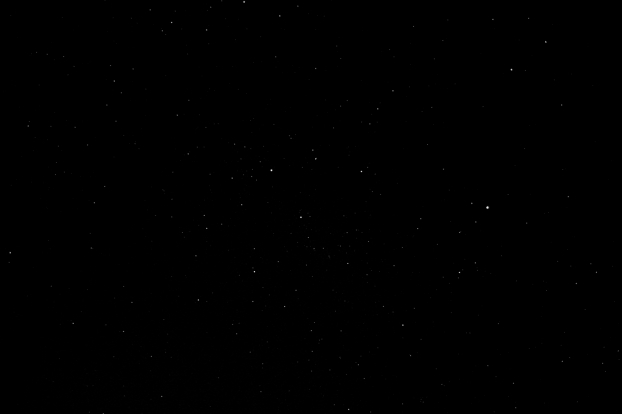 The story of the Swan starts with Helios, the god of the Sun, who fathered a son, Phaithon, with the Oceanid, Klymene who was the wife of King Merops of Ethiopia. When Phaithon wanted evidence of his parentage, Helios promised him any gift he wished. Phaithon asked to drive his father's chariot across the sky on the following day. Helios felt obliged to grant the wish and allowed Phaithon to take control of the chariot, but it proved too much for Phaithon and there was a grave danger that the Earth would be destroyed by the heat as he flew too low. Zeus intervened to save the Earth by throwing a thunderbolt and knocking Phaithon out of the chariot. (One assumes this enabled Helios to take control again, but the myths are not specific.) Phaithon's blazing body fell to Earth and plunged into the River Eridanos. His body was buried by the local nymphs and he was mourned by his mother and sisters, the Heliades. Another relative who came to grieve for his friend was Kyknos, king of the Ligurians in Italy. He grieved ceaselessly, wandering along the river banks singing of his loss until the gods took pity on him and turned him into a swan. Remembering Zeus's thunderbolt, he shunned the skies and chose to stay on the water well away from fire. When finally his time came he was transported into the sky as the constellation Cygnus. Both Phaithon and the river Eridanos were also immortalised in the sky as their own constellations, Auriga and Eridanus.
The story of the Swan starts with Helios, the god of the Sun, who fathered a son, Phaithon, with the Oceanid, Klymene who was the wife of King Merops of Ethiopia. When Phaithon wanted evidence of his parentage, Helios promised him any gift he wished. Phaithon asked to drive his father's chariot across the sky on the following day. Helios felt obliged to grant the wish and allowed Phaithon to take control of the chariot, but it proved too much for Phaithon and there was a grave danger that the Earth would be destroyed by the heat as he flew too low. Zeus intervened to save the Earth by throwing a thunderbolt and knocking Phaithon out of the chariot. (One assumes this enabled Helios to take control again, but the myths are not specific.) Phaithon's blazing body fell to Earth and plunged into the River Eridanos. His body was buried by the local nymphs and he was mourned by his mother and sisters, the Heliades. Another relative who came to grieve for his friend was Kyknos, king of the Ligurians in Italy. He grieved ceaselessly, wandering along the river banks singing of his loss until the gods took pity on him and turned him into a swan. Remembering Zeus's thunderbolt, he shunned the skies and chose to stay on the water well away from fire. When finally his time came he was transported into the sky as the constellation Cygnus. Both Phaithon and the river Eridanos were also immortalised in the sky as their own constellations, Auriga and Eridanus.
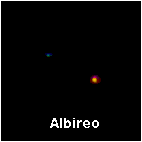 The brightest star, Deneb, is an exceptionaly brilliant supergiant at least 160,000 times as bright as the Sun, and Sadir is another giant about 23,000 times as massive as the Sun. Albireo, β-Cygni, is one of the most beautiful coloured double stars in the sky. The primary is orange, magnitude 3.0, and the secondary is blue and magnitude 5.1, and they are separated by 33 arc-seconds, making them an easy target in a small telescope. I have a few more pictures of mutiple stars below..
The brightest star, Deneb, is an exceptionaly brilliant supergiant at least 160,000 times as bright as the Sun, and Sadir is another giant about 23,000 times as massive as the Sun. Albireo, β-Cygni, is one of the most beautiful coloured double stars in the sky. The primary is orange, magnitude 3.0, and the secondary is blue and magnitude 5.1, and they are separated by 33 arc-seconds, making them an easy target in a small telescope. I have a few more pictures of mutiple stars below..
χ (not visible in my picture but close to 17) is a Mira-type variable with a period of 407 days, but has an unusually large range of brightness. At its brightest it can reach magnitude 3.3 but at minimum can reach magnitude 14. It is also one of the brightest infra-red sources in the sky. R-Cygni is another Mira-type variable which is particularly red (I cannot identify it, but it is roughly where I have indicated with a broken arrow).
There are two open clusters in the constellation. M29 which is close to γ, and M39 which lies approximately half way between Deneb and the stars of Lacerta. NGC 7000 is the North America nebula, an emission nebula that looks like the north American continent.
The picture was taken with my Canon 1000D DSLR with a focal length of 18 mm, an exposure of 20 seconds at f/3.5, ISO 1600. It was reduced from the original 10 megapixels and enhanced by increasing the contrast and decreasing the brightness to reduce the background to near black. This process lost many of the fainter stars but I felt that this made the main stars of the constellation stand out better. The Milky Way passes through this constellation, and you can see a more aggressively processed image, designed to bring out the Milky Way if you click on the picture.
To me, a double star is any pair of stars so close in the sky that they appear to be one to the naked eye—the two stars might be associated but may simply be in the line of sight. If the two stars are gravitationally bound and orbiting about one another, then the star is a binary star. Thus a binary star is a special case of a double star. Obviously the distinction extends to multiple stars where three or more stars are too close to resolve with the naked eye. Here are examples of binary stars with a third, unrelated component. All the pictures were taken with my DFK camera at prime focus of my LX00. The first three are on the same scale as all my other pictures of double stars, but the fourth picture has been reduced to 50% of its original size and was made as a mosaic of two pictures.
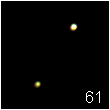
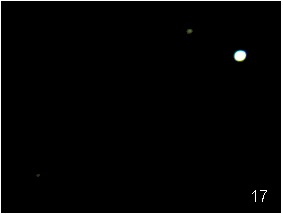
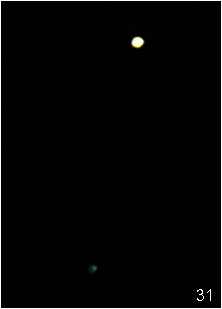
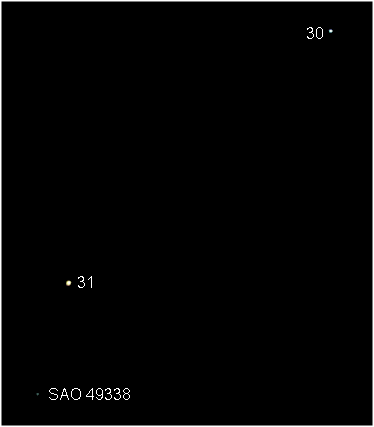
61-Cygni is a true binary and one of the closest stars to us at 11.5 light-years. It has the distinction of having one of the largest proper motions known. The stars are separated by about 84 AU and orbit one another in 659 years.
The close components of 17-Cygni are a binary. The third star, SAO 68833, is unrelated to the other two.
31-Cygni is a special case of binaries called an eclipsing binary. The two stars orbit one another in 3794.3 days in a plane that intersects the Earth, so eclipses occur. This is extremely valuable for the study of stella atmospheres. An eclipse occured in the autumn of 1982 so I estimate that the next should occur towards the end of 2013. 30- and 31-Cygni are sometimes listed as a double star called ο1-Cygni, but their separation is 338 arc-seconds. Human 20-20 vision can resolve 120 arc-seconds, but these stars are very dim (magnitudes 4.8 and 3.8 respectively) and I don't know how many people could resolve the pair in really dark skies. I certainly cannot in my location and nor was my camera able to do so.